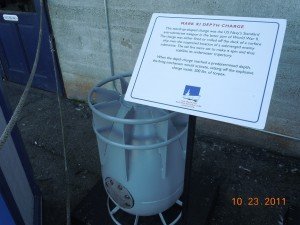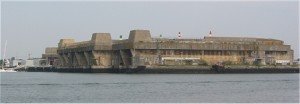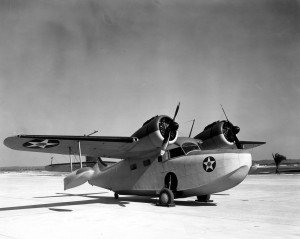Sometimes a name became so famous it finds itself attached to more than just one boat. Such was the case with the name of the famous Confederate General Robert E. Lee. One famous Mississippi steam boat was named the Robert E. Lee and much has been written about it’s famous race against the steamboat Natchez in 1870. There was another vessel of the same name whose story almost faded from history and then suddenly reappeared about sixty-years later in 2001. This story is about the World War Two sinking of the passenger ship Robert E. Lee. This is also the story of the U-Boat U-166. Both vessels ended up being the boat that sank and all of this occurred in the Gulf of Mexico during 1942.
Thank you for reading this post, don't forget to subscribe!The Steamship Robert E. Lee

There’s an interesting story about a ship named the Robert E. Lee that took place during World War Two, long after the Mississippi River steamboat race. The Robert E. Lee was a combination freight/passenger steamship owned by the Eastern Steamship Line. One of the things that make this particular story so unique is that it occurred not far off the shore of the southern U.S. and it involved combat…combat against German U-Boats… something we typically associated with events that happened far away from America’s shores. This historic incident took place within fifty miles of U.S. soil. U-Boats in World War 2 operated just a few miles off America’s southern shores.
The Gulf of Mexico War Theater of War
The Gulf of Mexico was a fairly active area during the war. While battles were taking place in Europe and Africa and in the Pacific Theater, German U-Boats were infiltrating the Gulf of Mexico via the Straits of Florida between Key West and Cuba. The goal of the Germans in this area was to disrupt shipping. Ports along the southern United States in Louisiana and Texas were critical to America’s war effort. Oil tankers regularly left ports bound for the European continent. Allied ships were sunk. Shipping was being disrupted. German U-Boats were having a measure of success and as a result the United States put into effect many countermeasures.

Protecting Gulf Shipping
The U.S. maintained several army airfields in both Texas and Louisiana. Aircraft were deployed routinely over the Gulf to search for U-Boats. Naval and Coast Guard vessels were on regular patrol searching for the U-Boats and when and if found would drop depth charges. Coastal blackouts were the rule of the day. The city of Galveston Texas had forced blackouts at night to reduce the chance of U-Boat attack. The city itself was not the prime target of course but the ships passing by were. A ship passing a city along the shore at night would cast a silhouette which could be detected by a prying U-Boat periscope. Ships as standard procedure would travel without running lights however background lighting had to be kept to an absolute minimum. Ships passing by Gulf coast cities were a prime target for the U Boat submarine.

To give you an idea of the scope of activity in the Gulf of Mexico during the war years, the following statistics are revealing. Over seventy ships, both naval and merchant, were U-Boat victims in the Gulf of Mexico. Fifty-six vessels were sunk outright. It has been said that at least twenty U-Boats were active in the Gulf at any one time. The peak U-Boat Gulf activity was during the years 1942 and 1943. German World War 2 submarines were a constant threat to Allied shipping.
The Robert E. Lee and the Sunken U-Boat
According to U.S. Government reports, there was only one German U-Boat officially sunk in the Gulf of Mexico. This was U-166 which had sailed to the Gulf from the German U-Boat Base at Lorient France. To this very day the U-Boat remains in a watery grave just off the mouth of the Mississippi River. The area of U-166’s final resting place is also just a few hundred yards from the sunken wreckage of the SS Robert E. Lee. As it turned out, the SS Robert E. Lee was the last victim of U-166. This particular U-Boat was reported to have sunk a total of four Allied ships.

The SS Robert E. Lee, built in 1924 in Newport News Virginia, was attacked on July 30th 1942 about forty-five miles southeast of the entrance to the Mississippi River. The steamship had been on a planned route from Trinidad to Tampa and then on to New Orleans. During it’s voyage, the ship was actually diverted from Tampa and simply continued to New Orleans from Trinidad accompanied by a U.S. Naval escort ship, PC-566. One of the ironic things regarding the passenger list of the steamship involved was just who made up most of the passenger list. It just so happened that by a quirk of fate the Robert E. Lee’s passengers were mostly survivors of previously torpedoed ships on their way to the United States.
Two additional articles on our Western Trips site you’ll find interesting are Galveston’s World War Two Defenses and the Defenses of San Francisco Bay.
The Attack
On the night of July 30th 1942 the SS Robert E. Lee was hit with a torpedo just aft of it’s engine room. The torpedo was spotted by lookouts at about 200 hundred yards from the ship but there was no time to avoid being struck. The engines and steering were wrecked and the Robert E. Lee sunk in about fifteen minutes. Twenty-five people lost their lives in the sinking of the Robert E. Lee.
Naval patrol craft, PCC-566, which had been escorting the steamer spotted the U-Boat periscope and gave chase. PC-566 dropped ten depth charges. An oil slick was spotted shortly afterwards but without any other evidence there was the possibility that the German U-Boat escaped the scene.

The Amazing Discovery of the Robert E Lee and U-166
Although, the Robert E. Lee was certainly sunk, U-166 became a kind of “Flying Dutchman” of the Gulf. After the oil slick was spotted after the 1942 attack, the boat was never heard from or seen again. Efforts to find the wreck, if there was one, were never successful. It took many decades but in the year 2001 the German U-Boat, U-166, was discovered at the bottom of the Gulf of Mexico, and then by accident. Scientists working for a firm searching the Gulf of Mexico seabed for a suitable pipeline location found the wreck of the Robert E. Lee. Less than two miles away was discovered another wreck. Images of the second wreck discovered by the underwater cameras didn’t fit any already identified wrecks cataloged for that area. By the same token it did resemble the missing U-Boat.
As it turned out, the wreckage was later confirmed to be U-166. Intensive camera exploration of the exterior of the sunken vessel was undertaken in 2003. Indentations were spotted that would be consistent with depth charge explosions. There was also evidence of possible secondary explosions after the pressure hull was punctured. Camera images show that the U-Boat had broken in two during the counterattack by PC-566. The wreckage of the Robert E. Lee lies mostly intact in over 4,500 feet of water. This makes it beyond the range of recreational divers. In the case of the World War II submarine U-166, the site where this vessel lies has been designated a “war grave” due to the fifty-two of her crew entombed there. This prohibits any attempts in the future to salvage the wreckage.
(Photos from the public domain unless otherwise stated)
